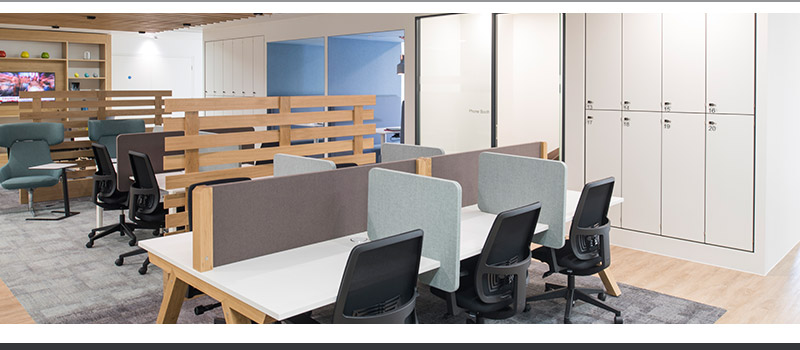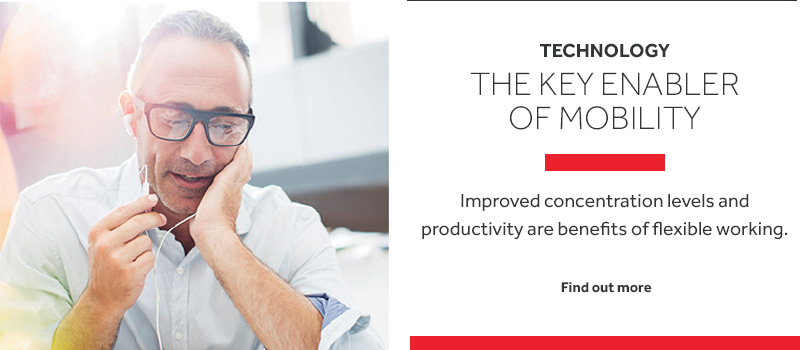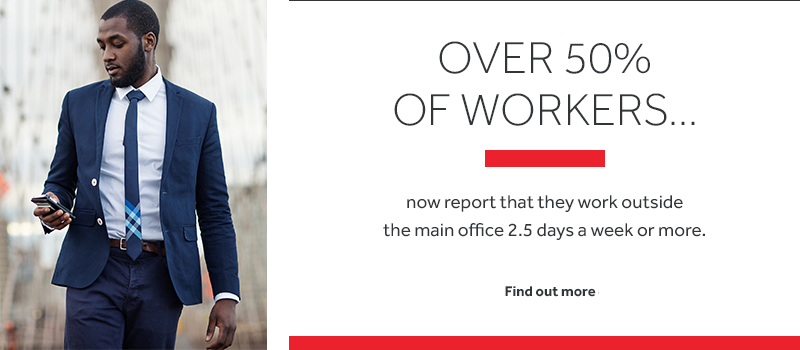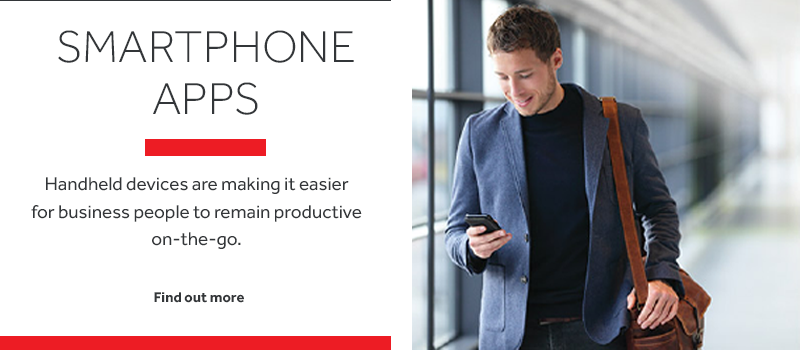The Workplace Revolution – a picture of flexible working 2017
We have been commissioning research on workplace trends for over 10 years. This research, which canvasses the opinions of over 20,000 senior managers and business owners, explores the increasing trend in flexible working around the world. This report reveals how businesses are adapting to this change, one of the most significant developments in working practices for decades.
Download the full report here.
It would be impossible to talk about remote working without acknowledging the role of technology as a key enabler of mobility: business people are able to work outside one of their main office locations, or indeed outside of an office at all, thanks to ubiquitous Wi-Fi and mobile devices such as smartphones, tablet computers and even trusty old laptops. Without these devices business people would have to constantly return to their office to send an email, talk to their colleagues, check a document or print off files.

Technology on the go
The speed at which technology has evolved means that not only are business people able to take their work around the city as they hop from meeting to meeting, or home in the evening, but they are also able to carry out these tasks and remain cost-effectively connected with their team or their management thanks to solutions that have made even telephoning seem cumbersome and old-fashioned.
Examples of these solutions are:- instant messaging, that replaces, for the employee working remotely the act of leaning across their desk to ask a colleague a quick question; or VoIP, that allows users to call or videocall very cost-effectively from their devices. Yet all these solutions are predicated on one key ingredient: a strong and fast internet connection. Without this, mobile working is severely limited.
The Millennial effect
Another key driver of remote working is the changing workforce: as generations grow-up expecting to be able to communicate cheaply and rapidly from anywhere in the world, it follows they expect this to also be the case in the professional arena. A whole host of literature is available analysing and outlining the different attitude towards work:life balance that younger generations (starting from Millennials) are introducing and making the norm in the world of work.
Specifically, a generation that is completely aware of how impossible it is to switch off technology and make oneself unavailable for even a few hours, is clamouring to at least be able to enjoy the reverse of this phenomenon and to carry out their work tasks freely from any location they choose.

The changing face of the workforce
It’s not just younger generations, however, that are demanding and enjoying a more flexible work environment. Older workers, forced to (or choosing to) delay retirement are also better able to combine their personal life with continued workforce participation if they are not required to face a gruelling daily commute.
This latest survey also shows that today’s workforce is increasingly composed of freelance workers and consultants as well as part-time workers who actively seek out the opportunity to work more flexibly.
Flexible working and its benefits
From spending more time on leisure and loved ones, to cutting down commute times and finding more time to relax, workers prefer flexible working for a host of reasons and for many it has now become a key differentiator when faced with a choice between similar jobs.
This is an important aspect to consider for businesses seeking to acquire top talent, as today’s workers are reporting that it’s not just salary which makes a difference. Add to this the fact that our research shows improved concentration levels and productivity are benefits of flexible working, and the business case is made.
As more and more workers demand to work flexibly, and with all the technology available to enable them to do so productively, it is hardly surprising to find that businesses are marrying their need for greater agility (rapid response to market changes) with helping workers achieve greater personal happiness and work:life balance.
This research shows that the trend towards increasing use of flexible work locations instead of fixed leasing arrangements doesn’t only concern SMEs but is actually applicable to all types of firms.
Regus and the workplace revolution
Taking a more flexible approach to how they manage their premises as well as hiring more consultants and freelance workers allows businesses to be more responsive and better placed to embrace growth, as well as navigating choppy waters should they arise.
In short, today’s workplace is becoming radically different from that demanded by the previous generation – a phase change compared to twenty years ago – and this reflects the composition of the workforce which is now richer in flexible working roles and more open to valuing employees on performance rather than face-time. As the world of work evolves, Regus is at the front line, taking its pulse and helping businesses grow and prosper.
Report summary
The world of work is being dramatically propelled into the future faster than ever before by a heady mix of new technologies and the demands of a workforce that is increasingly calling for a better work:life balance. In fact, over 50% of workers now report that they work outside the main office 2.5 days a week or more.
But where are business people carrying out their work if they are not in the main office? Almost a third report they work from different locations in the same city and a quarter say they are working from other cities suggesting that business people are finding they need to remain productive while on the move and between meetings.
Homeworking and its pitfalls
Only 36% say they exclusively work from home when remote and it’s easy to see why: workers report that home working is seriously damaging for productivity and doesn’t convey a professional image with family members, with pets and household noises disturbing calls and concentration levels. More importantly, workers report that at home they are unable to access key office equipment and a reliable and speedy internet connection.
Although working closer to home helps business people improve their schedule and see more of their families, they clearly would rather not work within the home and report that working remotely is ideal to help them be closer to client meetings.
The importance of technology
One of the main enablers of flexible working is of course technology. A number of apps allow workers to remain connected and productive at all times from laptops, tablet computers and smartphones. Similarly, business people are making more and more use of solutions that let them access files and desktops remotely through Cloud applications.
Technology already provides these workers with all they need to stay connected with their teams and access their files and documents wherever they are. Specifically, VoIP calls and instant messaging apps are increasingly used by workers on-the-go to keep in touch with colleagues and staff cost-effectively: all that is required is a fast internet connection to make them feel as though they are in the office.
And management agree, reporting that rather than relying solely on expensive and invasive IT to track productivity, workers should simply be having regular meetings and catch up phone calls.

The rising voice of the workforce
The other key driver of flexible working is worker demand: as businesses report that they are seeing more consultants and freelancers populate the workforce, it is hardly surprising that the need for flexible workspace is also expected to continue to grow.
Combine this with the need to find a better work:life balance (voiced by Millennials and by an increasing number of people adapting their working habits in order to remain in employment beyond pensionable age) and you have the perfect recipe for a more mobile workforce.
But businesses stand to benefit too, with firms of all sizes expected to embrace the demand to work more flexibly and to promote agility by reducing fixed office costs and avoiding fixed leasing arrangements.
Flexible Working – the Global Context
Reports confirm that today’s workforce is radically different to that of just twenty years ago. Not only have new technologies enabled ways of working that would have seemed impossible just a few decades ago, but the speed of reaction required by every worker – as well as the sense of being always connected and available over email or telephone – have given rise to a greater need for work:life balance and for workers to carve out personal time in a world where professional and leisure ‘space’ have become increasingly confused.
From mobiles to work mobility
Smartphone penetration in the UK now stands at a staggering 91% for 18-44 year olds and over 70% for Belgian, Dutch and German adults. France falls slightly behind the EU average at 61% and is closer to the Chinese 62% but still remains well above 50%.
It is not surprising, therefore, to find that apps that have been specifically designed for mobile use are becoming increasingly popular and at the same time further driving flexible work by making it easier for business people to remain productive on-the-go and for teams to stay connected.
In 2015, global mobile app revenues amounted to $69.7 billion and in 2020, mobile apps are projected to generate $188.9 billion in revenues via app stores and in-app advertising, signalling that more and more users will be downloading and making daily use of these tools. Users prefer apps to mobile sites and spend 90% of mobile time on them rather than on browsers as confirmed by Flurry Analytics (June 2015).



No comments:
Post a Comment